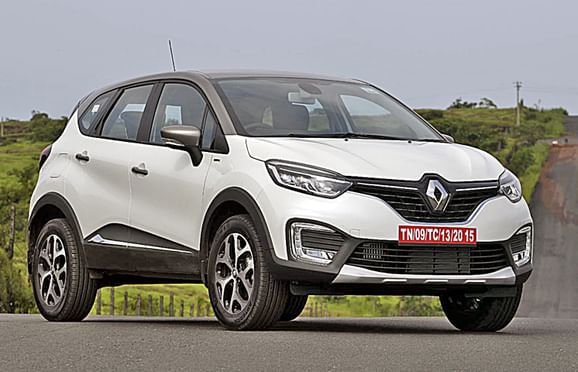What is it?
While it still hasn't quite reached the heights of its Indo-Japanese and Korean rivals, Renault has been making some interesting cars for the Indian market. While the levels of success seen by its models have been mixed, the French carmaker now wants to make a stronger impression in the mid-size SUV/crossover segment. But let’s face it, the competition here is pretty tough.The Hyundai Creta has more or less become the epitome of maximum bang-for-the-buck when it comes to features, while the newly arrived Jeep Compass has stirred up the market with its true-blue SUV credentials. The car that Renault thinks has what it takes to challenge these two is the Captur.
Here’s where a bit of confusion begins, though. No, this is not the same Captur that’s sold in Europe. That one is built on the Clio platform, and thanks to the Euro-spec bells and whistles, would’ve cost a bomb to bring here. The Captur we’re getting is one that’s specifically made for emerging markets, built on the company’s M0 platform that’s proven its mettle in the Duster. In fact, it’s already gone on sale in Russia but is spelt ‘Kaptur’ thanks to the the letter ‘C’ being pronounced as 'S' in the Cyrillic alphabet.

From the outside, it’s almost impossible to tell that the Captur is based on the Duster platform. It mirrors the European Captur’s design language, with swooping lines, curves and minimum angles, making it inherently French in its aesthetics, contrasting the Duster’s more Romanian origins. Even with the Captur’s graceful lines, it still manages to have a butch quality, thanks to the wide and squatter stance compared to something like the Hyundai Creta. Big wheel arches over the wonderfully designed ‘crystal cut’ 17-inch wheels sporting 215/60 rubber and the massive 210mm ground clearance lend it the unmistakable proportions of an SUV. To add to that, the Captur’s short bonnet is muscular, drooping down at the front into an elegant headlight cluster, and culminating in a chunky bumper with 'C'-shaped units that house LED daytime running lamps (DRL) and fog lamps.
Speaking about LEDs, there are lots of them across the car. Apart from the aforementioned DRLs and fog lamp combo, the tail-lights, as well as the headlights, are also full LED. There’s LED ambient lighting on the inside as well, but more on that later. Overall, it’s a very refreshing design unlike anything else seen in this segment before. But, in spite of the Captur being a looker, Renault is offering a whole multitude of customisation options in the form of garnishes such as chromed trim parts, several roof graphics and even two preset themes for those would have a difficult time choosing individual parts.
What’s it like inside?
While there’s nothing to complain about the chic exteriors, the interiors are a bit of a hit-and-miss. The wrap-around dashboard is a fresh design and certainly feels like a step up from the Duster's. There are also some great design touches such as the butterfly-shaped instrument cluster that gets a large digital speedometer in the centre, flanked by a tachometer and a fuel gauge. And I really like the ambient LED lighting and design of the air conditioner controls. However, our biggest gripe is the type of materials that have been used for the dashboard and the overall use of hard plastics for the interiors. They don’t feel as upmarket as they should for a car in this category, especially the roof liner which feels like it's from one full segment below.
Then there are some slightly wonky design elements, like the centre armrest – it doesn’t fold away and interferes with the operation of the handbrake lever. We really hope that all variants of the Captur offer hill- hold assist; trying to start moving from a standstill on an incline will be quite tricky otherwise. Then there are the front seats. Only the driver’s seat gets height-adjust, which is fine. What isn’t fine, however, is the fact that even the lowest setting on the seat is so high that it not only gives you a commanding view of the road but also of the entire top of the very large dashboard; this serves as a visual reminder of the basic quality of plastics that populate much of the cabin. And, if you’re on the taller side, say over 6ft, you are going to be uncomfortably close to the roof. The other ‘fit’ issue with the Captur can be found in driver’s footwell. The pedals are well proportioned and placed, but forget a dead pedal, there’s almost no space to the left of the clutch. This means the driver needs to keep his left foot under the clutch pedal when cruising; not an easy transition to make if you have large feet.
Renault made a big deal about its ‘panoramic’ windscreen and minimal A-pillars, along with the quarter windows designed to provide you much better situational awareness of what’s around and in front of you. While the side-to-side visibility is great, sitting so high up behind a raked windshield cuts out a bit of the view of the sky. Now, this isn’t a problem when it comes to driving, but it does give you a feeling of looking at the world through a narrow letterbox.
The front seats themselves aren’t too bad though. The two-tone white- and-black leatherette seats look and feel good, and there's enough support for your back and under-thighs, as well as sufficient bolstering for your shoulders when tossing the car around corners. The design and similar contouring are seen on the rear seats as well. While two adults, or even three in a pinch, can sit fairly comfortably, the kneeroom is nothing to write home about, and the rising window line robs the back of some airiness. The rear cabin space also gets its own set of AC vents which should be useful on hot days.
The top-spec Platine trim that we drove came with a 7.0-inch touchscreen multimedia system that offers a number of connectivity options such as Bluetooth, USB and aux-in. It even gets integrated maps and navigation. The interface in use here is the traditional Renault one seen in the Kwid and the Duster but this one seems to be running a crisper screen resolution and readability in sunlight is a lot better now. Even though it’s fairly responsive and quick, from a design and usability perspective, it’s not really on par with the best in the game. In this day and age, we’d have liked to see Apple CarPlay and Android Auto offered, but all you get is basic iPod functionality through USB and some voice commands for iOS. One complaint we have with the layout of this system is the placement of the USB port; the cable dangles over the screen when plugged in.
What’s it like to drive?
Renault offers the tried-and-tested 1.5-litre H4K petrol mated to a five-speed manual and a 1.5-litre K9K diesel motor with a six-speed manual on the Captur in India for now. On our first drive, we got the diesel version and we were quite impressed with it. This DCi motor makes 110hp and 240Nm like in the more powerful version of the Duster, but refinement levels have really hit a new high. On the Captur, this engine is the quietest it's ever been.
This 1.5 DCi motor has always had a bit of turbo lag and it’s the same story with the Captur. However, once spooled up, power delivery is punchy and the motor pulls strong and smooth almost all the way up to 4,700-4,800rpm. Power doesn’t trail off rapidly like a typical diesel and this makes the Captur rather fun to drive. Of course, if it had delivered 20-30hp more, it would’ve been absolutely perfect. But it’s not that the Captur feels underpowered at speed. With a wide powerband like this, overtaking manoeuvres are a breeze. And combined with the car’s solid stability on wide open roads and fairly high speeds, it has all the makings of a great highway cruiser.
This enjoyable driving experience continues even on winding roads as the Captur is a very capable handler. The chunky steering is well weighted and it gives you a good feel of what’s going on with the front wheels. Although you do get some understeer if you get too ham-fisted with the steering, it keeps body roll well under control through twists and turns. Overall, if the way it drives had to be summed up in one word, ‘European’ come to mind.
Ride quality is another area that the Captur does really well in. It’s sprung a bit stiffer than the Duster, and it isn’t plush in the same way some of its competitors are, over broken roads it handles quite well. While occupants aren’t completely isolated from bumps, none of them are jarring, apart from the really sharp ones.
Should I buy one?
The Renault Captur is certainly a very interesting proposition in this mid-size SUV space. With its typical ‘European Renault’ design owing to the shorter bonnet creating a cab-forward design, it looks like nothing else we’ve seen in this space in India. And that really earns it some strong brownie points against its competition. That said, the interiors, especially the choice of materials, do leave a bit to be desired. However, when it comes to the driving experience, there’s a lot of similarity to the other Renaults we’ve driven in India before, but it also manages to do some things a bit better.
In many ways, it’s like a dressed-up Duster – a Duster++ if you will – and that’s not a bad thing at all, considering just how capable the Duster actually is.
Safety is well taken care of as well with ABS, Isofix child seat mounts for the rear seats, and dual airbags as part of standard kit. Top-spec Platine edition additionally get side airbags, electronic stability control and hill start assist.
But what really works in the Captur’s favour is its attractive price. While prices for the petrol Captur, that is available in three trims, ranges from Rs 9.99 to Rs 11.70 lakh (ex-showroom, Delhi), the four-trim-strong diesel Captur range starts at Rs 11.40 lakh and tops off at Rs 13.89 lakh for the fully-loaded Platine edition. The prices not only make the Captur more affordable than chief rival, the Hyundai Creta, but also put the new Renault in the same price band as the Duster. Sure, there will be some cannibalisation between the Captur and Duster brands, but as things stand, Renault has two very distinct flavours of SUV for attractive money. The Hyundai Creta has some real competition on its hands.
Also read:




